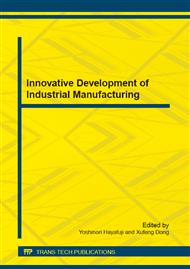[1]
M. C. Davis, J. W. Pahle, J. T. White and L. A. Marshall. Development of a flush air-data sensing system on a sharp-nosed vehicle for flight at mach 3 to 8[R]. 2000, NASA/TM-2000-209017.
DOI: 10.2514/6.2000-504
Google Scholar
[2]
Whitmore S A, Davis R J, Michael J F. In-flight demonstration of a real-time flush air-data sensing(RT–FADS) system[R].NASA-TM-104314,1995:1~17.
DOI: 10.2514/6.1995-3433
Google Scholar
[3]
Whitmore S A, Moes T R, Leondes C T. Failure detection and fault management techniques for flush air-data sensing system[R]. NASA-TM-4335, 1992: 1~19.
DOI: 10.2514/6.1992-263
Google Scholar
[4]
Whitmore S A, Moes T R. Measurement uncertainty and feasibility study of a flush air-data system for a hypersonic flight experiment[R]. NASA-TM-4627, 1994: 1~18.
Google Scholar
[5]
Cheng Chen, Jianwu Tao and Bin Zeng, Estimation of airspeed based on acoustic vector sensor array[C], In Proceedings: Proceedings of the 2012 IEEE 11th International Conference on Signal Processing (ICSP 2012), Vol. 1: 307-310, October (2012).
DOI: 10.1109/icosp.2012.6491662
Google Scholar
[6]
Zeng Bin , Tao Jianwu, Yu Fei, Qian Lilin, A new airspeed estimation method for supersonic flow[C], In Proceedings: Proceedings of 2013 IEEE International Conference on Signal Processing, Communications and Computing (ICSPCC 2013), pp: 1268-1271, August (2013).
DOI: 10.1109/icspcc.2013.6663889
Google Scholar
[7]
John D. Anderson, Jr. Fundamentals of Aerodynamics[M]. New York, McGraw-Hill. (2011).
Google Scholar
[8]
Qian Yiji. Atmost Aerodynamics[M]. Beijing, Beijing University Press. (2006).
Google Scholar
[9]
http: /www. microflown-avisa. com/acoustic-localisation/AVS. html.
Google Scholar
[10]
Ding Yuan, Wang Qing. ANSYS ICEM CFD from learner to master[M]. Beijing, Tsinghua University Press, (2013).
Google Scholar
[11]
Tang Jiapeng. FLUENT 14. 0 super-learning manual[M]. Beijing, Posts & Telecom Press, (2013).
Google Scholar
[12]
Microflowen. http: /www. microflown-avisa. com/acoustic-localisation/AVS. html.
Google Scholar
[13]
M. C. Davis, J. W. Pahle, J. T. White and L. A. Marshall. Development of a flush air-data sensing system on a sharp-nosed vehicle for flight at mach 3 to 8[R]. 2000, NASA/TM-2000-209017.
DOI: 10.2514/6.2000-504
Google Scholar


